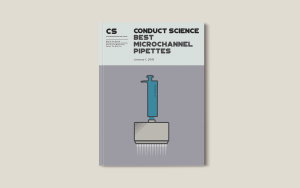
Best Microchannel Pipettes: A Comprehensive Guide
Introduction Pipetting, at first glance, would seem a fairly simple and easy task. Essentially described as glass or plastic tubes used to measure and transfer
The key to success can be found in the essential principles of the Resource Identification Initiative. The Resource Identification Initiative (RRID) is an innovative system for reporting research resources. It has been designed to support research and foster better reproducibility. Looking back, the Resource Identification Initiative was created to help experts find and use the resources implemented in studies and reported in papers. The initiative was started by the Neuroscience Information Framework and the Oregon Health & Science University Library, and it was launched in collaboration with numerous community members and parties, such as e-Scholarship. Note that resources can refer to various tools, such as antibodies, model organisms, and software products.
The Resource Identification Initiative has identified three broad requirements for it to be successful. First, experts have agreed that – as technology plays a crucial role in medicine – the standard should be machine-processable. In other words, the standard implemented in the Resource Identification Initiative is designed for search algorithms, as well as human understanding. Secondly, in a world that connects people freely via the wire, information should be available outside the paywall. Experts have realized the paramount role of the free biomedical literature, and therefore, the Resource Identification Initiative is an essential step toward free science. Last but not the least, the standard should be uniform across publishers, which will help experts erase ambiguity (Bandrowski et al., 2015).
Reproducibility is one of the main goals of the research. All studies add valuable insights to theory and practice, making replication and reuse two crucial aspects of science. Building upon the existing medical knowledge, testing research hypotheses, and replicating scientific experiments are all factors that can facilitate reproducibility. Therefore, the collaboration between institutions, data exchange, and transparent communication between experts can only support reproducible science.
However, researchers and businesses face numerous financial, ethical, and practical challenges. As a result, documentation practices suffer. In fact, biomedical literature often lacks vital details about resources and procedures. So, where is the key to success?
Apart from the three requirements described above, the Resource Identification Initiative has focused primarily on three types of research resources: model organisms, such as mice, primary antibodies, and software tools. It’s interesting to mention that the ambitious pilot study conducted by Bandrowski et al., 2015 showed that researchers were willing to include secondary antibodies and commercial tools as well, which proves that the Resource Identification Initiative is the desired reform. Note that other common resources used in medical studies are cell lines and knockdown reagents (Vasilevsky et al., 2013).
By having three types of research resources, the main goal of the Resource Identification Initiative is to give a unique ID to all resources used in research and reported in the literature. These are the so-called identifiers, which are the foundation of the Resource Identification Initiative. To achieve this goal, the RRID syntax is simple, generic, and optimized for machine-readable access.
In fact, there are three fundamental criteria for all resources and identifiers: to be machine-readable, free to generate and access, and consistent across publishers and journals. By following these criteria, the use of identifiers will foster transparency, improve communication, and support reproducibility.
The Resource Identification Initiative has enabled some vital features of research and reproducibility:
Transparency: The Resource Identification Initiative enables transparency and clarity. Experts can search for clear and accessible information by using unique identifiers (RRIDs). Identifiers can be employed to search for a particular research resource, which in addition, facilitates the use of search engines. Identifiers guarantee persistency, and this way, they erase ambiguity (Bandrowski et al., 2015). Let’s say that you’re looking for more information on an antibody. The truth is that many experts provide the catalog number given by their vendors, and unfortunately, vendors have different numbers for identical products. On top of that, when the product is sold, the catalog number just disappears.
Machine-readable: With the digitalization of medicine, tools should be adopted and optimized for machines. The Resource Identification Initiative embraces the future of research and helps experts create identifiers that are machine-processable. To be more precise, this feature guarantees that special characters that may be not recognized by a machine are not used when creating identifiers.
Easy to generate: The Resource Identification Initiative helps researchers generate unique identifiers. All authors are asked to provide unique resource identifiers for the resources they have used. Consequently, experts add identifiers to their papers to help other researchers and improve future studies. If a resource doesn’t exist, the Resource Identification Portal allows users to make new entries via the “Add a Resource.”
Consistent across publishers and journals: The Resource Identification Initiative strives for consistency. As stated earlier, information should be clear, transparent, and consistent. In other words, from San Francisco to Tokyo and from Glasgow to Sydney – researchers all over the world will be able to use consistent data in their work. Also, as mentioned above, funding agencies, vendors, and publishers work together and support researchers by using the Resource Identification Initiative platform. Perhaps the most appealing aspect is that the system is not a burden to experts and providers.
Free to access: Good reporting of materials and procedures is crucial. To answer the documentation demands of research, the Resource Identification Initiative has allowed free access to data.
With its appealing features, the Resource Identification Initiative holds numerous promises for research and businesses.
Research reproducibility: Scientific reproducibility has been a primary focus of interest in science. By being disposed to identify unique research resources, experts will be able to replicate experiments (Vasilevsky et al., 2013). In fact, reproducibility can be defined as the “conditions where test results are obtained with the same method on identical test materials in different laboratories with different operators using different equipment” (ISO 5725-1:1994, 1994).
Scholarly communication: The Resource Identification Initiative will help experts build upon each other’s published articles and results. Research information will be better documented – indicating issues and perspectives. Clear documentation will help experts cut costs and speed up research. If experts have access to good methodological reporting in published research, they will be able to replicate experiments accurately and extend medical findings.
A cultural shift in literature: The Resource Identification Initiative reflects the recent cultural shift in literature. Experts see journals and articles as valuable sets of data, and as such, they need to have clear identifiers to facilitate access, data management, and information exchange. Experts along with sponsors, vendors, and publishers can use the power of data, and the Resource Identification Initiative simply catalyzes this power.
Scientific results are linked to business strategies. Pharmaceutic companies, vendors, and providers can also benefit from research and literature. For instance, sales analytics may use vital data to analyze and predict sales. It’s data science. Data empowers businesses to understand the competitive business environment and gain more customers. Therefore, the Resource Identification Initiative is valuable not only for researchers but companies. Data obtained from the Resource Identification Initiative can help leaders analyze sets, visualize trends, target opportunities, and share insights.
Monitor use: The Resource Identification Initiative can help companies track the use and popularity of their products. As there’s a unique identifier for each product, products can be easily tracked in research and literature. As a result, by using vital data obtained from the scientific literature, companies can see how often their products have been used in practice. For example, as mentioned above, researchers can track the use of a particular antibody. The same applies to vendors who can analyze how well their products sell.
Understand your products: Healthcare analytics allows companies to analyze specific patterns, which can help businesses improve their services. Firms can see which types of products, such as software tools, are used the most, and improve their sales by limiting excessive investment and improving ad campaigns.
Improve sales and increase revenue: Although the main goal in medicine is improving patients’ health, we should agree that medical supplies and treatment may cost a fortune. Therefore, companies need to consider investment and funding. By joining the Resource Identification Initiative, suppliers will have access to valuable data and literature. From research and development data to clinical data, researchers and businesses will be able to explore their sales, the impact their services have in real life, and their revenue.
Gain customers: The information available through the Resource Identification Initiative gives you access to structured data. Structured data can help you improve your practices and consequently, gain more customers. Sometimes data that does not lead directly to turnovers is valuable – simply because it has predictive power and may help you establish long-term relationships with clients.
Want to dive into the data sets of the Resource Identification Initiative? We can help you comprehend the world of sales analytics better! Many organizations have realized that marketing groups are not enough for businesses to succeed. The world of healthcare and medicine is constantly changing, and therefore, only groups dedicated specifically to data mining and analysis can help you mine your progress (“Sales analytics”). The Resource Identification Initiative is a factor for your success, and we can make it happen.
Just tell us which product you want to focus on and what aspects of your business you’d like to improve. Leave the rest in our hands: we’ll track your products, monitor their unique ID numbers, review literature papers and provide valuable data that can benefit your sales analytics. On top of that, we can unveil all hidden aspects of research, such as fraud and audits, and help you cut down administrative costs and supplies by implementing technology in research and sales.
In conclusion, it’s not a secret that research provides mind-blowing findings. On top of that, the literature contains powerful sets of data that can support businesses in the field of healthcare. The Research Identification Initiative joins practice and papers to help parties work together. Datasets are not only an abstract term but our way to help you succeed.
Bandrowski, A., Brush., M., Grethe, J., Haendel, M., Kennedy, D., Hill, S., Hof, P., Martone, M., Pols, M., Tan, S., Washington, N., Zudilova-Seinstra, E., & Vasilevsky, N. (2015). The Resource Identification Initiative: A cultural shift in publishing. F1000Research, 4.
ISO 5725-1:1994 (1994). Retrieved from https://www.iso.org/standard/11833.html
Vasilevsky , N, Brush, M., Paddock, H., Ponting, L., Tripathy, S., LaRocca, G., & Haendel, M (2013). On the reproducibility of science: unique identification of research resources in the biomedical literature. PeerJ 1:e148 https://doi.org/10.7717/peerj.148
Sales analytics. Retrieved from https://www.techopedia.com/definition/30436/sales-analytics

Introduction Pipetting, at first glance, would seem a fairly simple and easy task. Essentially described as glass or plastic tubes used to measure and transfer

INTRODUCTION AND BRIEF HISTORY One of the most important pieces of equipment in the laboratory is the centrifuge, which facilitates the separation of samples of

INTRODUCTION AND BRIEF HISTORY One of the most important pieces of equipment in the laboratory is the centrifuge, which facilitates the separation of samples of

What Is a Good Impact Factor? Impact factor (IF) can be defined as the frequency with which a particular number of articles from a scientific






DISCLAIMER: ConductScience and affiliate products are NOT designed for human consumption, testing, or clinical utilization. They are designed for pre-clinical utilization only. Customers purchasing apparatus for the purposes of scientific research or veterinary care affirm adherence to applicable regulatory bodies for the country in which their research or care is conducted.